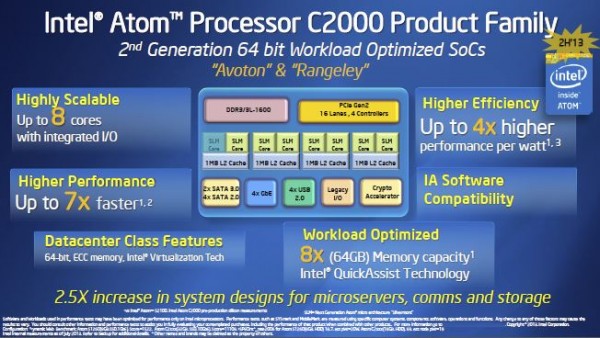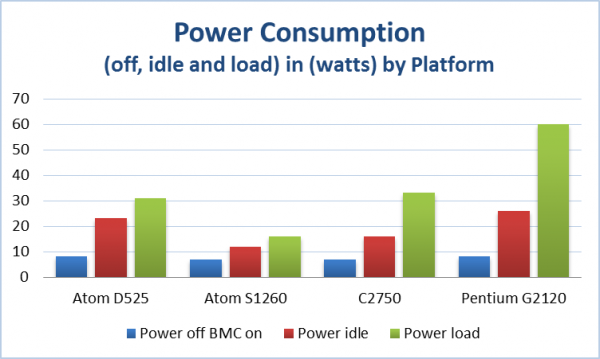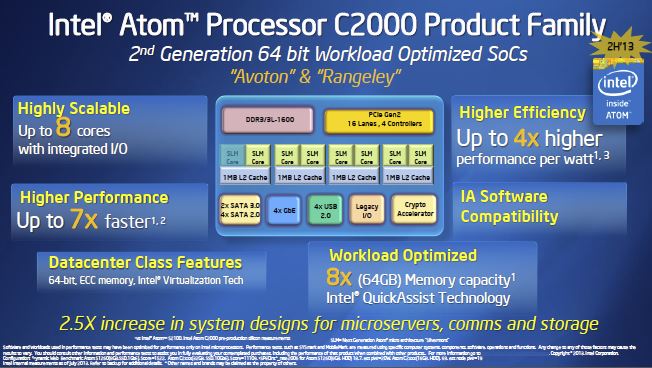We have had a great chance to do early testing of the Intel C2750 platform from Supermicro, the A1SAi-2750F. We provided a bit of context recently around the new Intel C2750 performance in both Windows and Linux. One of the big outstanding questions has been power consumption and we finally have some data to understand how the platform performs in some real world scenarios. We also are using one of the more “worst case” scenarios for the platform’s power consumption as we are using a total of 32GB of RAM. As expected, the Intel C2750 is using more power than the previous generation Intel Atom S1260 platform. On the other hand, it also brings with it an order of magnitude better performance. We decided to take an opportunity to look at the new C2750 SoC on the Supermicro A1SAi-2750F platform and compare it to previous generation Atom platforms as well as a Pentium G2120 server which offers a similar memory limit and supports VT-x but not VT-d.
Test Configurations
Since the Supermicro A1SAi-2750F has an onboard Avoton processor (see the second A in the model name) and an integrated 4-port gigabit NIC, it really is a platform where one can get a lot of use by simply giving it disk storage (or a network boot setup) and 2-4 SODIMMs. Similarly, we also setup other test platforms to give a good idea regarding where this system falls in comparison to other similar systems. Here are the configurations we used:
Intel Avoton/ Rangeley C2750
- Motherboard/ CPU: Supermicro A1SAi-2750F with Intel C2750 Avoton 8C/ 8T SoC
- SSD: Intel S3700 100GB SSD
- Memory: 32GB (4x 8GB) 1600MHz 1.35v Kingston KVR16LSE11/8 DDR3 SODIMMs
- OS: Ubuntu 13.10 daily (20 September 2013)
- Power supply: 1U 200w 80+ Gold PWS-203-1H
Intel Atom S1260
- Motherboard/ CPU: Supermicro X9SBAA-F with Intel Atom S1260 processor
- SSD: Intel S3700 100GB SSD
- Memory: 1x 8GB Kingston Low-Power ECC 1333MHz DDR3L SODIMM
- OS: Ubuntu 13.10 daily (20 September 2013)
- Power supply: 1U 200w 80+ Gold PWS-203-1H
Intel Atom D525
- Motherboard/ CPU: Supermicro X7SPA-HF-D525 with Intel Atom D525 processor
- SSD: Intel S3700 100GB SSD
- Memory: 8GB (2x 4GB) 1333MHz 1.5v Kingston DDR3 SODIMMs
- OS: Ubuntu 13.10 daily (20 September 2013)
- Power supply: 1U 200w 80+ Gold PWS-203-1H
Pentium G2120 Test System
- Processors: Intel Pentium G2120
- Motherboard: Supermicro X9SCM-F
- SSD: Intel S3700 100GB SSD
- Memory: 32GB (4x 8GB) 1600MHz 1.5v Kingston DDR3 DIMMs
- OS: Ubuntu 13.10 daily (20 September 2013)
- Power supply: 1U 200w 80+ Gold PWS-203-1H
Overall we tried using a fairly standard type configuration for Avoton and Rangeley platforms as well as other platforms. Kingston sent us the 4x 8GB low power 1.35v DIMMs we will be doing a piece shortly on the impact of 1.35v DIMMs versus 1.5v versions. One major item of note here is that the DIMMs to make a noticeable power consumption impact on these types of systems. Also, the Intel C2750 is certainly a platform that you will want to check compatibility lists for. Thanks to Kingston for getting us SODIMMs quickly to complete this piece.
What we are really looking at here is the claim that the Avoton / Rangeley platform sips power. We already saw initial benchmarks showing the platform is significantly faster than previous generation Intel Atom architectures. Here is Intel’s roadmap slide with the family claiming higher performance per watt:

Power Consumption Tests
We took measurements at three important processor states: system off, OS idle and fully loaded. Those are typically the data points that most folks want to see with these platforms. As is standard, our the Extech 380803 True RMS power analyzer was utilized for the measurements in a 70F/ 21C ambient room.
- The first was at platform off with all five Ethernet ports plugged in. In this phase we see power driven mostly by the onboard BMC which provides out-of-band (OOB) control functionality. It is estimated that over 80% of the server market now has OOB control functionality. This test therefore shows power consumption of a network connected node that is in its off state ready to be brought up on demand.
- Our second test allows the machine to get into an OS idle state and the network adapters active but there is not any significant traffic running over the network connections.
- Finally we test the components under heavy load, both with the processor and with the network ports being fully loaded. Note for this test, the Intel C2750 platform is at a significant disadvantage. It has four gigabit NICs connected while the other two systems only have two gigabit NICs onboard.
The results we saw were as follows:

Overall, a very strong showing by both the Intel Atom S1260 and the Avoton / Rangeley platforms. It should be noted that this test is slightly skewed with both Atom platforms having only 8GB of DDR3 DRAM. This is the maximum we could use in each. Likewise, the Avoton / Rangeley platforms are being hampered by having two additional gigabit network links active. From another angle, the Avoton / Rangeley Intel C2750 is providing a tremendous amount of performance with 32GB memory capacity in a fairly low power setup.
In our first test, we are clearly seeing that keeping the ASpeed AST2300 or AST2400 BMC online is a relatively low power affair which helped keep results similar between each platform when the power was off. With the power on and OS idle, we see that the SoC solutions tend to provide the best options. With the power at full throttle, again, the Avoton platform is pushing 50% more data out than the other solutions but delivers middle-of-the-pack performance. Atom D525 owners beware: Rangeley will provide a much better platform at similar or lower power consumption. For the simple pfsense, Untangle, or Vayatta appliances this may not be a major reason to upgrade but for those looking to do more with a low power server, this is clearly crossing the line into where Intel’s low power architectures never could.
Conclusion
Overall, these are some great figures for the overall performance of the new platform. The key here is that for an always on simple router/ firewall appliance, such as a pfsense 2.1 machine, the older Atom S1260 generation machine makes sense. It does offer lower power and at a lower initial cost. On the flip side the Avoton / Rangeley have changed what we would expect a low end platform to be and now offer a compelling case for virtualizing those applications. Our full performance review will be out shortly but suffice to say, Avoton / Rangeley offer much better performance, however under a slightly higher maximum power envelope.





holy heck. I heard Intel did something amazing but looks like this is a big leap over what they did with the Bay Trail side. Crazy good.
Why isn’t AMD listed on here?
Dude – I looked at that benchmark post on Avoton – at that level of power consumption that is awesome.
Now we just need to get Intel to start fabbing these SOCs so we can actually buy boards. Any word on ASRock or ASUS or Gigabyt Avoton and Rangeley boards? I saw ASrock has them.
Why not compare to the new xeon e5? Or e3v3?
At least all Ivy Bridge desktop processors only sip 10W of idle power with the right powersupply and SSD (2 DIMMs). Especially interesting: G3220
Maybe a consumer motherboard. Not 10w with an active BMC and all three NICs active.
I would be interested to see if this could serve as a NAS server on a Supermicro or the announced Asrock mobo’s with 10 SATA ports. It has low power with probably enough kick to get solid read and write speeds. I was looking at the recently announced Xeon E3-1220L v3 for this, but maybe this can serve as well. Hopefully you can do a comparison between the Avoton and some other processors for specific user scenarios like a NAS, would be great!
I would love to see that too!
Patrick,
You state in this article the use of this Avoton with Linux UTM such as Untangle and PfSense. Does this mean the Aspeed video chip works with these platforms? Also would Sophos UTM be included in that mix too were this server would work out of the box in the hardware compatibility area?
Why use a 200W power supply when these things are drawing under 75W? I wonder how they’d fare with a pico-psu. I suppose maybe you were going after a real-world 1U power supply, but I wonder how much is lost in just that PS – even if it is fairly efficient, it’s pretty oversized for these systems, no?